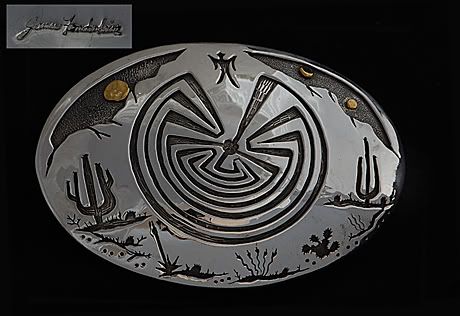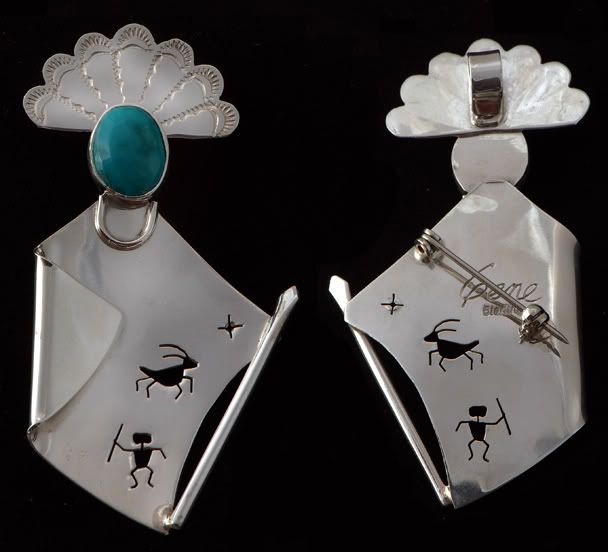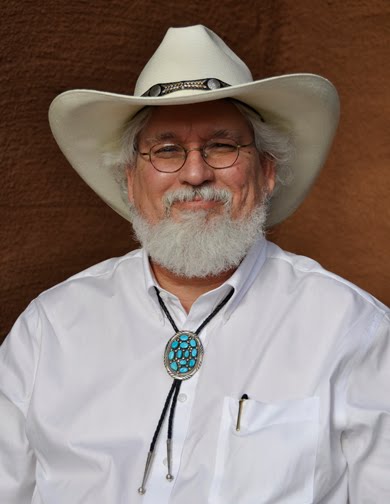 Andrea Lonjose Shirley's lapidary work has no equal that I'm aware of. A distinctive feature of Zuni jewelry is exacting fit that often goes beyond what one expects of mere mortal hands. The casual observer might mistake the piece shown as a masterful example of a small Champlevé painting. Champlevé is an enamel technique in which troughs are carved into the surface of a metal framework then filled with a vitreous enamel. The piece is then fired until the enamel melts then polished after cooling. The "Zuni Ball Eye Kachina" shown is inlaid on sterling silver with mother of pearl, acoma jet, coral, and sleeping beauty turquoise. On close-up inspection there is no mistaking it for a Champlevé piece. It stands 3.5 inches tall and can be worn as pin or pendant. Cost = $599.00.
Andrea Lonjose Shirley's lapidary work has no equal that I'm aware of. A distinctive feature of Zuni jewelry is exacting fit that often goes beyond what one expects of mere mortal hands. The casual observer might mistake the piece shown as a masterful example of a small Champlevé painting. Champlevé is an enamel technique in which troughs are carved into the surface of a metal framework then filled with a vitreous enamel. The piece is then fired until the enamel melts then polished after cooling. The "Zuni Ball Eye Kachina" shown is inlaid on sterling silver with mother of pearl, acoma jet, coral, and sleeping beauty turquoise. On close-up inspection there is no mistaking it for a Champlevé piece. It stands 3.5 inches tall and can be worn as pin or pendant. Cost = $599.00.
Monday, September 29, 2008
Andrea Lonjose Shirley
 Andrea Lonjose Shirley's lapidary work has no equal that I'm aware of. A distinctive feature of Zuni jewelry is exacting fit that often goes beyond what one expects of mere mortal hands. The casual observer might mistake the piece shown as a masterful example of a small Champlevé painting. Champlevé is an enamel technique in which troughs are carved into the surface of a metal framework then filled with a vitreous enamel. The piece is then fired until the enamel melts then polished after cooling. The "Zuni Ball Eye Kachina" shown is inlaid on sterling silver with mother of pearl, acoma jet, coral, and sleeping beauty turquoise. On close-up inspection there is no mistaking it for a Champlevé piece. It stands 3.5 inches tall and can be worn as pin or pendant. Cost = $599.00.
Andrea Lonjose Shirley's lapidary work has no equal that I'm aware of. A distinctive feature of Zuni jewelry is exacting fit that often goes beyond what one expects of mere mortal hands. The casual observer might mistake the piece shown as a masterful example of a small Champlevé painting. Champlevé is an enamel technique in which troughs are carved into the surface of a metal framework then filled with a vitreous enamel. The piece is then fired until the enamel melts then polished after cooling. The "Zuni Ball Eye Kachina" shown is inlaid on sterling silver with mother of pearl, acoma jet, coral, and sleeping beauty turquoise. On close-up inspection there is no mistaking it for a Champlevé piece. It stands 3.5 inches tall and can be worn as pin or pendant. Cost = $599.00.
Thursday, September 25, 2008
Silver Spurs
 In the days of chivalry spurs and the metal from which they were made were a mark of rank. Hence the expression "to earn your spurs." Today they are a standard piece of cowboy equipment; designs vary widely. I've found only three Native American Silversmiths willing to rise to the challenge of crafting spurs. The first was the late Harry Morgan. I located a pair of his excellent spurs in a showcase at an area dealer shortly after starting this business. When I asked about price, I was clearly told--not for sale. This year, much to my delight, I found two pair entered into competition at the 87th Gallup Intertribal Ceremony. Both were dazzling. One pair was done by Gary Reeves (Navajo), the other by his equally talented brother Sunshine Reeves. I passed on the opportunity to buy, somewhat to my regret which was reversed today when I found and bought the winning blue ribbon pair by Sunshine Reeves. At an appraisal price of $6000, these sterling silver blue ribbon winning spurs may indeed be hard to earn.
In the days of chivalry spurs and the metal from which they were made were a mark of rank. Hence the expression "to earn your spurs." Today they are a standard piece of cowboy equipment; designs vary widely. I've found only three Native American Silversmiths willing to rise to the challenge of crafting spurs. The first was the late Harry Morgan. I located a pair of his excellent spurs in a showcase at an area dealer shortly after starting this business. When I asked about price, I was clearly told--not for sale. This year, much to my delight, I found two pair entered into competition at the 87th Gallup Intertribal Ceremony. Both were dazzling. One pair was done by Gary Reeves (Navajo), the other by his equally talented brother Sunshine Reeves. I passed on the opportunity to buy, somewhat to my regret which was reversed today when I found and bought the winning blue ribbon pair by Sunshine Reeves. At an appraisal price of $6000, these sterling silver blue ribbon winning spurs may indeed be hard to earn.
Thursday, September 18, 2008
Stanley Parker's Traditional Old Style Navajo Jewelry

Stanley Parker (1952..) was born and raised on the Navajo reservation in the shadow of the great Shiprock located in the 4 corners region of New Mexico. Unlike many of his contemporary competitors who had the early advantage of childhood home schooling in the fine art of silversmithing, he learned his skill later in life. As a young man, he began working in the electronics industry soldering circuit boards, but he was subsequently drawn to silvermithing as a career after watching others work in the medium. He told me that his experience soldering electronic circuits facilitated his transition to working with silver. I was very impressed with his work I first discovered at a wholesale distributor in Albuquerque. I met him two years running at the Santa Fe Indian Market, but it wasn't until last week that he called me and asked to visit me here in Gallup. Two things about Stanley's work that really stand out are: 1) master silversmithing and 2) choice of natural turquoise. His silver work is so precise that it looks machine made, only on careful inspection in most cases can one see "maker-marks." Stanley is very careful in his choice of stones and finding satisfactory "cabachons" for mounting is his biggest production frustration. He used to cut his own from raw materials, but now finds he doesn't have the time to cut and polish. His fine work understandably commands high prices. The bracelet above featuring the rectangle of King Manassas turquoise is $435.00.
Monday, September 8, 2008
Zuni Canteen
 The ability to craft a good canteen is the mark of an accomplished silversmith, an art among the Navajo that goes back to around 1880. It was in that year that Washington Matthews, a Ft. Wingate, NM army officer, published an account of silversmithing in which a silver canteen was described and illustrated. In that era they were popular among the soldiers as tobacco flasks. The great modern Navajo canteens I've seen among the Navajo were crafted by Harry Morgan, Sunshine Reeves, and Gary Reeves. The above mini-canteen was made by Carlton Jamon of Zuni. The canteen shown measures only 3 inches from top to bottom and about 3/4 of an inch in thickness. Thus, it is clearly designed for use as a perfume carrier as they were popularly used by Navajo women in the early 20th century. They would buy perfume at the trading post then put their pleasant fragrance in one of these small canteens to carry securely tied to the bottom of a strands of beads. The above sterling silver canteen is accented with the 12K gold petroglyphic hand, sleeping beauty turquoise, and malachite. The silver surface is both textured and shinning. I was able to buy only this one piece, but Mr. Jamon appeared anxious to make more for me, so I hope to keep them on hand in EBay store. Price $700.
The ability to craft a good canteen is the mark of an accomplished silversmith, an art among the Navajo that goes back to around 1880. It was in that year that Washington Matthews, a Ft. Wingate, NM army officer, published an account of silversmithing in which a silver canteen was described and illustrated. In that era they were popular among the soldiers as tobacco flasks. The great modern Navajo canteens I've seen among the Navajo were crafted by Harry Morgan, Sunshine Reeves, and Gary Reeves. The above mini-canteen was made by Carlton Jamon of Zuni. The canteen shown measures only 3 inches from top to bottom and about 3/4 of an inch in thickness. Thus, it is clearly designed for use as a perfume carrier as they were popularly used by Navajo women in the early 20th century. They would buy perfume at the trading post then put their pleasant fragrance in one of these small canteens to carry securely tied to the bottom of a strands of beads. The above sterling silver canteen is accented with the 12K gold petroglyphic hand, sleeping beauty turquoise, and malachite. The silver surface is both textured and shinning. I was able to buy only this one piece, but Mr. Jamon appeared anxious to make more for me, so I hope to keep them on hand in EBay store. Price $700.
Saturday, September 6, 2008
Tohono O'odam Jewelry
 I had the privilege of living with my young family among the Tohono O'odam (formerly Papago) Indians on their reservation in the Sonoran Desert of Southern Arizona for two years in a decade past. It was there that I met Nick, a full blooded Papago, who became one of the best friends I've ever had. The friendship came about when Nick refused to sell me a horse; but interestingly, he had no hesitation in loaning me one indefinitely. So it was that I spent many hours mounted high in the saddle of my stallion named Gu-Achi. Nick would frequently invite me on wild horse round-ups with his Tohono O'odam buddies and he's take me out to hunt javelina, deer, quail, or to round up beef on the hoof for slaughter. Hardly a week passed that Nick and I missed adverturing in the desert mountains or home on the range in that beautiful, but hostile desert land where the stately Saguaro cactus, lifespan up to 200 years, weigh in at thousands of pounds each, and grow 40 ft upward to skies that are rarely cloudy all day. The Papago are noted for their remarkable tightweave, decorative baskets made from native grasses and Devil's claw. Their mini-baskets are woven and shaped from horsehair. Sandy and I collected quite a few baskets, but silverwork was scarce and we acquired only two pieces I showed in a blog entry several months ago. And so it is that we learned first hand to appreciate the people and land of the Tohono O'odam.
I had the privilege of living with my young family among the Tohono O'odam (formerly Papago) Indians on their reservation in the Sonoran Desert of Southern Arizona for two years in a decade past. It was there that I met Nick, a full blooded Papago, who became one of the best friends I've ever had. The friendship came about when Nick refused to sell me a horse; but interestingly, he had no hesitation in loaning me one indefinitely. So it was that I spent many hours mounted high in the saddle of my stallion named Gu-Achi. Nick would frequently invite me on wild horse round-ups with his Tohono O'odam buddies and he's take me out to hunt javelina, deer, quail, or to round up beef on the hoof for slaughter. Hardly a week passed that Nick and I missed adverturing in the desert mountains or home on the range in that beautiful, but hostile desert land where the stately Saguaro cactus, lifespan up to 200 years, weigh in at thousands of pounds each, and grow 40 ft upward to skies that are rarely cloudy all day. The Papago are noted for their remarkable tightweave, decorative baskets made from native grasses and Devil's claw. Their mini-baskets are woven and shaped from horsehair. Sandy and I collected quite a few baskets, but silverwork was scarce and we acquired only two pieces I showed in a blog entry several months ago. And so it is that we learned first hand to appreciate the people and land of the Tohono O'odam.The James Fendenheim buckle shown above is a byproduct of another highlight (that of meeting James) at this year's Santa Fe Indian Market. I first encountered James at his booth where we talked silver and he told me how to get in touch with the other notable Tohono O'odam jewelry maker. He was not interested in selling wholesale to me so I could market his work worldwide, but he was happy to sell me the buckle above at show's end to feature in this blog. If you would like to see more of James' fine quality work click here. The above Western style buckle retails for $900 dollars, it is accented with 18K gold and features, the saguaro cactus and the Man (James calls the figure Star Man) in the Maze, both are very commonly depicted in Tohono O'odam art.
Wednesday, September 3, 2008
Gene Billie's Sterling Silver Sculptures
 I did not have long to spend at Gene Billie's (Navajo) booth at the recent Santa Fe Indian Market. It was buzzing with folks admiring his table top size silver sculptures. I was intrigued with a small corner of his table where he was exhibiting small jewelry derivates of his larger works. as you see in the image of the pin/pendant here. The petroglyph figures are small cut outs. This piece is entitled Native Spirit's Celebration. It measures 1.5 x 2.75 inches.
I did not have long to spend at Gene Billie's (Navajo) booth at the recent Santa Fe Indian Market. It was buzzing with folks admiring his table top size silver sculptures. I was intrigued with a small corner of his table where he was exhibiting small jewelry derivates of his larger works. as you see in the image of the pin/pendant here. The petroglyph figures are small cut outs. This piece is entitled Native Spirit's Celebration. It measures 1.5 x 2.75 inches.
Subscribe to:
Posts (Atom)

